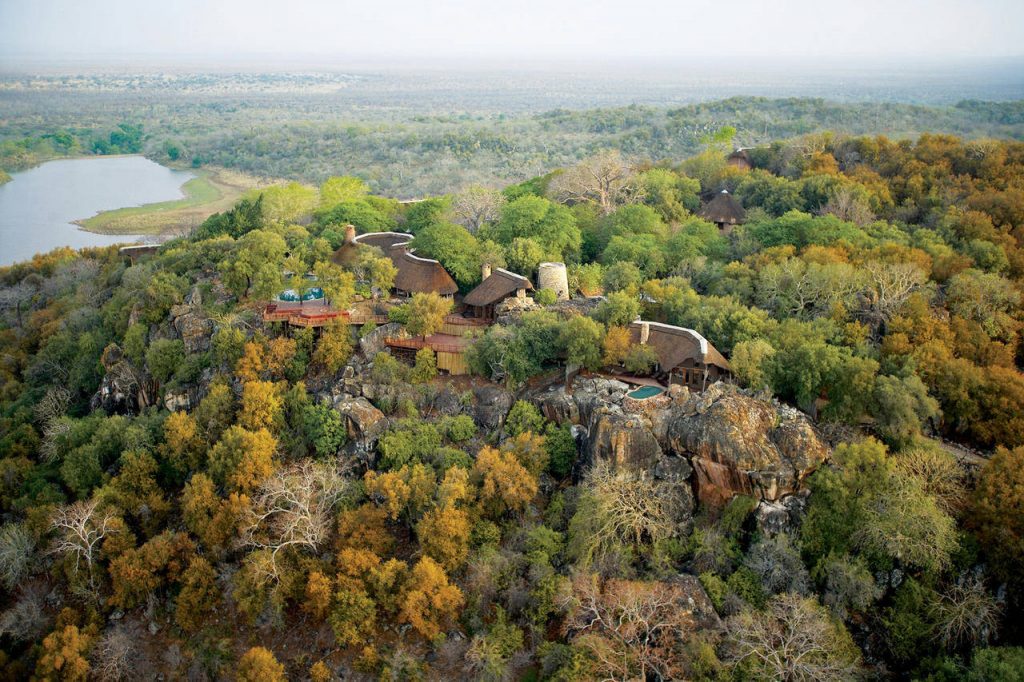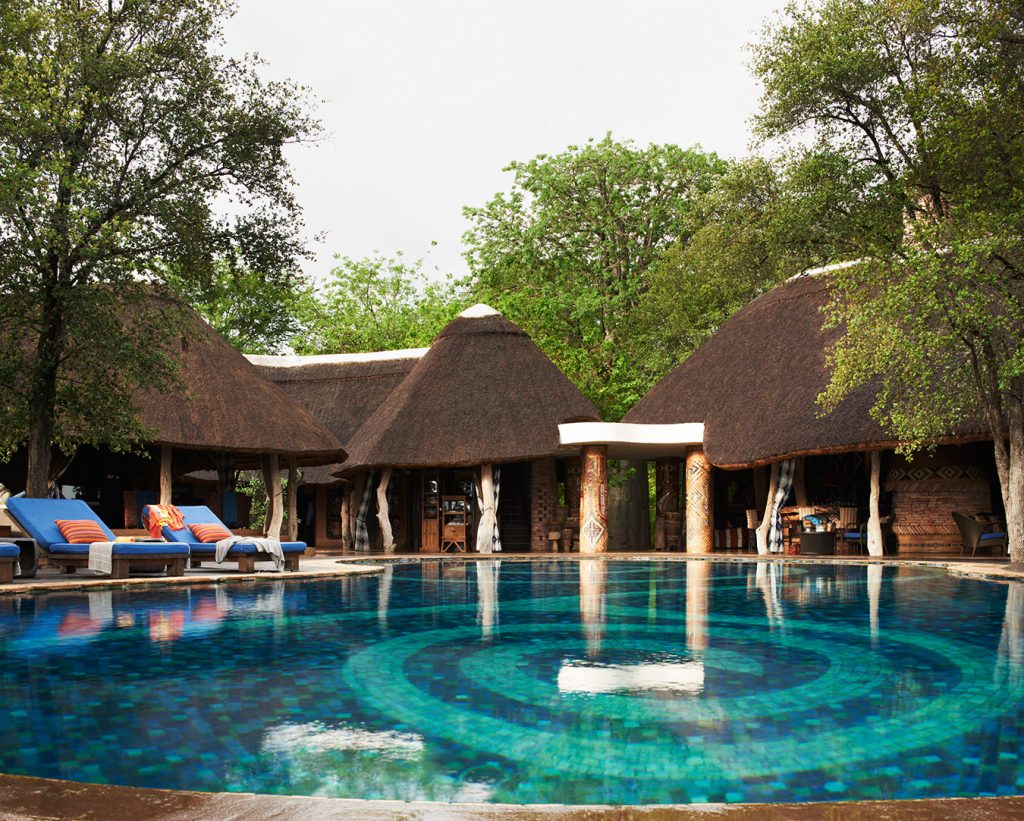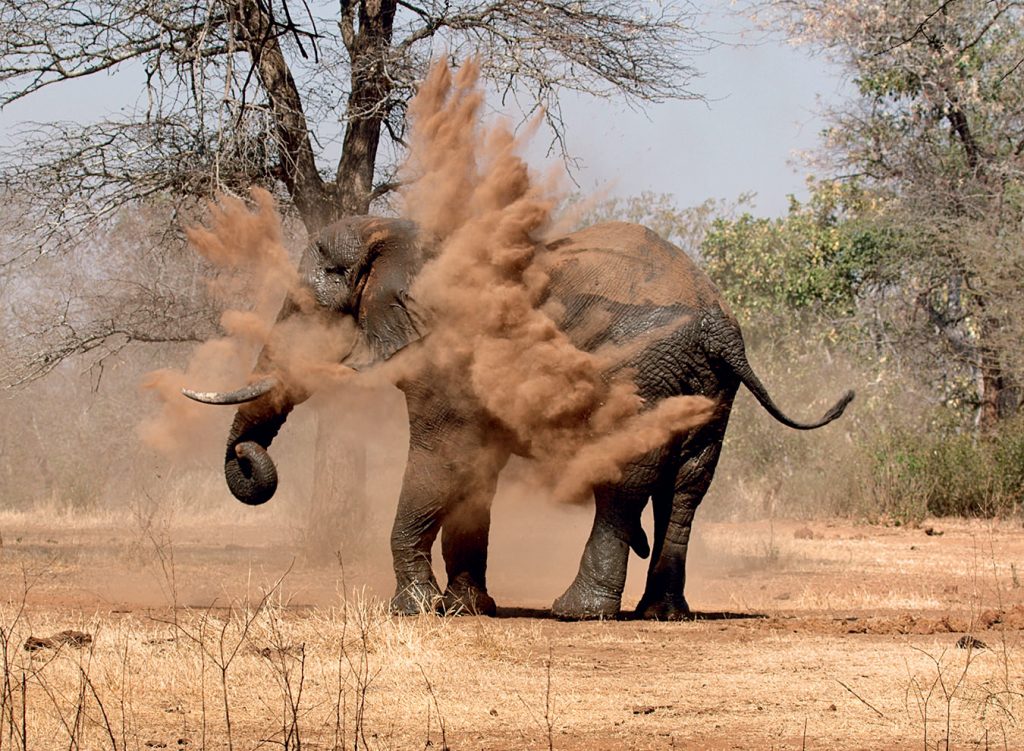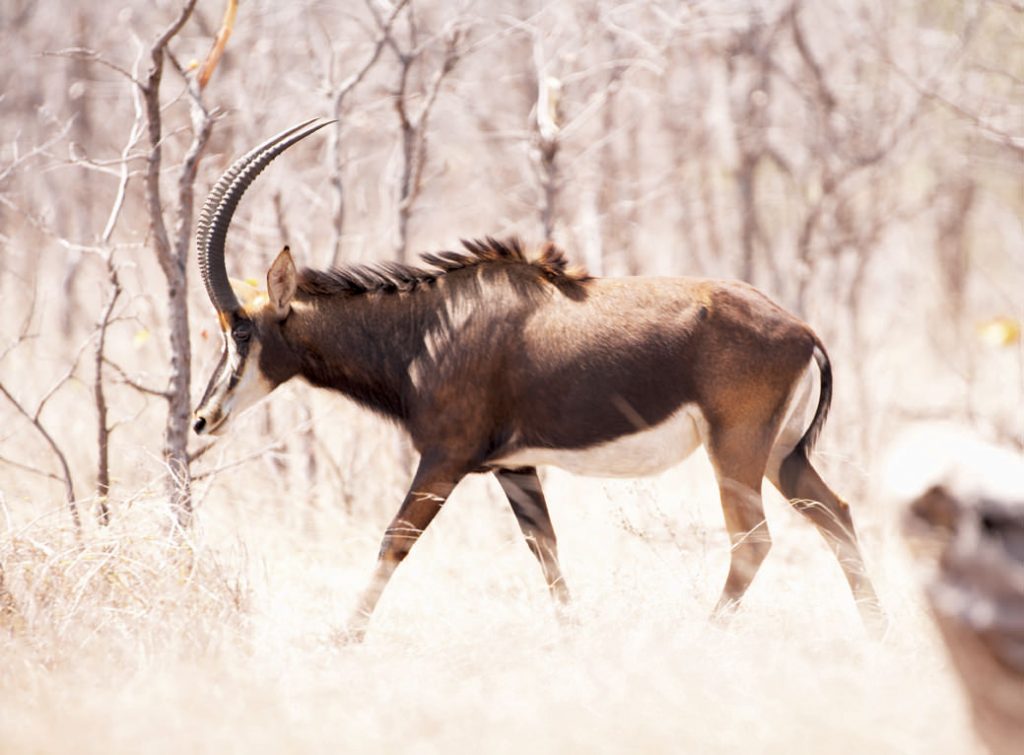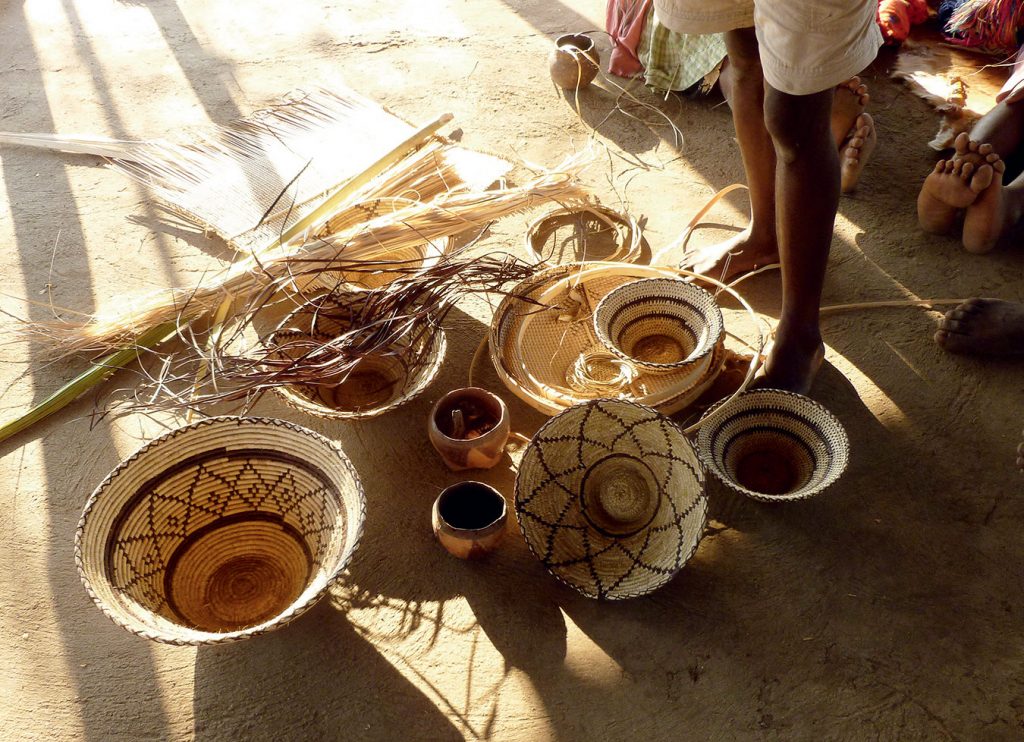The baobab tree, the great sage of the Lowveld, is a defining icon of the African savannah. Its provenance is addressed in various myths; in legend, even among different African peoples, the tree is a bit of a black sheep, but that seems to be the reason why it is thought of so fondly. In one popular tale, the god Thora disliked the tree and threw it out of his garden; it landed upside down and continued to grow. And so the baobab stands for resiliency. It persists and provides, and so the beloved baobab also symbolizes wisdom, strength, health, and longevity. The baobab tree is where paths converge, and humans and animals alike are welcomed in their outstretched arms.
We journey to Singita Pamushana Lodge, located in a remote part of southeastern Zimbabwe within a 130,000-acre private reserve. Malilangwe Wildlife Reserve is a protected swath of wilderness bound in the west by riparian woodland flanking the Chiredzi River. The Malilangwe Trust was established in 1994 as a custodian for wildlife conservation within the bounds of the reserve and to facilitate neighbouring community development. Low-volume luxury tourism was begun to increase revenue for the trust’s projects, and in 2008, Singita was brought on board to manage and continue operations. The existing lodge was refurbished, and Pamushana, Shangaan for “a place in the sun”, was launched.
As we step out of the cramped twin-engine plane at Buffalo Range International Airport, the cloudless sky opens up dizzyingly over the flat, flat land. It is quiet but not still. The change of pace is immediately apparent. There is no sense of urgency here, and particularly none felt by the single customs officer on duty. The waiting area is quaint: it is painted a cheerful seafoam green complemented by a grey trim along the floor, which is missing a few tiles here and there. The fan stands still.
Upon arriving at Singita Pamushana, the group wends its way up a beautifully landscaped stone path through sycamore fig trees and is welcomed at the top of the hill with a cool towel and a glass of champagne. The entrance area extends outward to a breathtaking view of a massive, 1,500-acre Malilangwe Lake. A Swarovski telescope instantly brings us into the company of hippos bobbing in the water, crocodiles basking in the sun, and African fish eagles poised patiently in tree branches. (For other anglers visiting the lodge, there’s bass, catfish, bream, and, for a good fight, tiger fish.) The effect of gazing across this expansive open landscape is an enveloping serenity.
When on safari in Africa, you rise with the sun, because that’s when the animals begin to stir.
The lodge itself is nestled harmoniously into the wooded area. The thatched roofs, made by craftsmen using elephant grass, keep the building cool. Sandstone boulders, sun-bleached leadwood trunks, and rock fig wood are integrated into the overall design. Singita Pamushana is spacious, yet intimate, with six sumptuous rooms as well as a lavish five-room villa. Boldly coloured and patterned motifs in the linens and the bathroom mosaics are a lively pop in contrast to the dark wood and brick. It’s a splendid place to rest before beginning a new adventure.
When on safari in Africa, you rise with the sun, because that’s when the animals begin to stir. A light snack is all that’s necessary before the first game drive of the day at the break of dawn. We pile into a Land Cruiser, and one of the lodge’s beloved guides whisks us into the wilderness. We quickly discover that our senses, dulled by a prosaic city life, fail compared with the acute eyesight and hearing of a professional guide or tracker. Tengwe Siabwanda, a second-generation field guide, can spot zebras crossing the path miles away and tiny birds flitting in the branches, all from a moving vehicle. It’s astonishing.
The terrain changes quickly, and we drive through mopane forests, acacia woodlands, and ironwood thickets. There are 57 large mammal species, and more than 500 species of birds, including 60 species of raptors. We meet the skittish kudu, hiding in the bush; the homely wildebeest; comical warthogs; trumpeting elephants, leaving trampled foliage in their wake; and giraffes knocking heads together in an awkward skirmish. We pull up close to a small lake and three female lions, panting in the heat; a short but safe distance away is a small cluster of zebras, giraffes, and impalas. We watch them watch the lions and the water source. “Nobody wants to die,” says Tengwe.
Malilangwe, which means “call of the leopard” in Shangaan, is also a sanctuary for threatened species including Lycaon pictus, also called the Cape hunting dog, the African wild dog, and the painted wolf. Once spread across sub-Saharan Africa, these gregarious creatures have suffered habitat loss and poaching over the last hundred years; their numbers have now been reduced to less than 5,000. The cantankerous black rhinoceros is a critically endangered species; these prehistoric beasts had once disappeared completely from the region, but recently reintroduced, they thrive today.
Upon our return to the lodge, our appetites have caught up to us, and as we are seated for breakfast, it becomes clear that we’re not the only ones feeling peckish. Little white-headed buffalo weavers hover in the rafters, hoping to steal a bite from the buffet of fresh fruit, nuts, and grains when no one is looking. Guests who aren’t used to viewing these winsome creatures as bothersome pests find it difficult to shoo them away, but it’s quickly apparent that the locals have no such reservation.
While staying at the lodge, guests are also encouraged to become acquainted with the Malilangwe Trust’s developmental programs. Shepherd Mawire is the community development coordinator and oversees projects focusing on eight different areas such as HIV/AIDS and malaria awareness, cultural support, education, and food and nourishment. In February 2003, after Zimbabwe experienced two consecutive years of acute drought, the Child Supplementary Feeding Programme was launched by the Malilangwe Trust in association with the national government of Zimbabwe and supported by Singita Pamushana. Mawire admits that the CSFP is very expensive to maintain, “but honestly speaking, if we were not to continue, with malnutrition and dietary diseases—we have a very serious motivation.”
“We encourage kids. We can build our own country if we stay here.”
Each school morning, 19,000 children between six months and 12 years of age in a 50-kilometre radius on the outskirts of the Malilangwe Wildlife Reserve receive a fortified meal made from a corn and soya blend by volunteer mothers. The ingredients are purchased, transported, and delivered by Singita Pamushana. Mawire explains that because the CSFP is available only to children who attend school, the program is indirectly inviting them to show up to class. “We encourage kids,” he says. “We can build our own country if we stay here.” In many cases, it is the only balanced meal of the day that the children receive. Sometimes, it is the only meal the children receive.
Education is critical to move the country forward, but it is also important not to forget the history of its people and where they came from. The Kambako Living Museum of Bushcraft, part of the trust and located just beyond the Malilangwe Wildlife Reserve, serves a very important purpose: preserving knowledge that is nearing obsolescence. Like neighbouring tribes, the Shangaan people developed an intimate relationship with their natural environment that sustained them through the centuries. Their existence depended on being able to make fire, craft effective weapons, and discern nutritious plant from poisonous gourd. (Some beneficial plants grow next to similar-looking deadly ones, and one must follow the roots to tell the difference.) As Julius, the patriarch of the family that operates the living museum, says, “There is no shortcut.”
Delegation was also important for Julius’s ancestors, and the division of labour was quite clear: “Men’s work is men’s work. Women’s work is women’s work,” Julius says. But today, in the name of equal opportunity, we are given a demonstration of the male-designated tasks of yore and encouraged to try cracking a four-foot whip (a painful learning experience), firing an arrow at a battered target (immensely satisfying), setting a trap for small rodents (intricate, but intuitive, once you get the hang of it), and divining for water (the key is choosing a fresh branch).
It is an enriching experience to visit the Kambako Living Museum and witness the strength, patience, tenacity, and ingenuity that the Shangaan’s ancestors had, and recognize that these qualities are still within the people today. Like the deeply rooted baobab tree, Zimbabweans are nothing if not resilient, peaceful people. Guests also have the opportunity to view rock art created by the San people, the original hunter-gatherers and one of the oldest continuous cultures on earth. They have one of the oldest genetic lineages and are likely descendants of peoples ancestral to all modern humans. The paintings are a mind-boggling 2,000 years old.
It is difficult to know what to expect when travelling to Zimbabwe for the first time. Bad news travels fast, and far; political unrest is a known and delicate issue. But other things are happening, too. During the end of our short stay, it is clear that we have only seen the tip of the iceberg, but it’s an effective introduction to a beautiful land and a dynamic community. This is a place the locals affectionately call “Zim”, and it is more approachable than before. Mawire understands that the Malilangwe Trust cannot rely on donors alone, but he believes it is important to show people that “even with the little that we have, we can still make a difference.”

